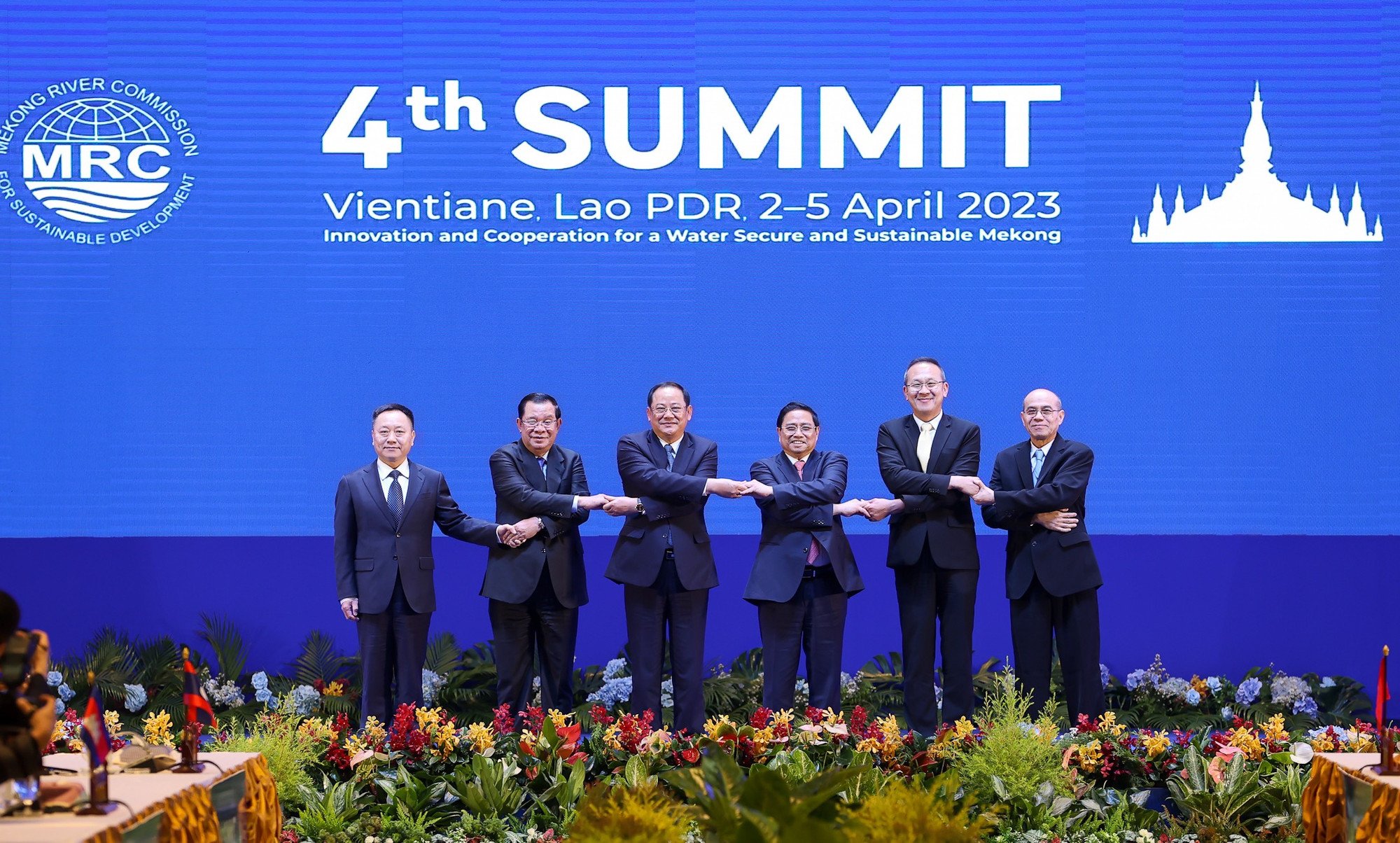
Successes and limitations
The Mekong River Commission (MRC) was established on April 5, 1995, when four member countries, Cambodia, Laos, Thailand and Vietnam, signed the Agreement on Cooperation for the Sustainable Development of the Mekong River (1995 Mekong Agreement) (1) . China and Myanmar share the Mekong River with four MRC member countries, but did not join the MRC, participating as observers. The main objective of the MRC is to promote cooperation among member countries in the use, coordination, management and development, and protection of water resources and related resources in a sustainable manner , including not only in the fields of irrigation, hydropower, waterway transport, flood control, fisheries, rafting, recreation and tourism (2) , but also for the common interests of each member country and people in the Mekong River basin. The MRC has a relatively complete structure, including the Mekong Summit (3) , the Annual Council Meeting, the Joint Committee and technical meetings (4) . The MRC has three permanent bodies: 1- Council, 2- Joint Committee and 3- Secretariat. Since its establishment, the Secretariat has had its headquarters in Phnom Penh (Cambodia); since June 2004, it has been located in Vientiane (Laos). Each member country has established a National Mekong River Committee which operates as a part of the MRC, is a support body of the MRC and has a Secretariat .
Among the major river basin organizations in the world , MRC is an early organization with a relatively complete legal framework and scale of cooperation on transboundary water resources management; at the same time, it contributes to promoting solidarity and multifaceted cooperation among the Mekong River countries. Since its establishment, MRC has achieved many positive results, contributing to promoting cooperation and development in member countries, expanding cooperation with two upstream countries, China and Myanmar, and many other international partners. MRC programs support upstream and downstream flow regulation and provide knowledge, experience, and technical support tools for member countries to jointly research and develop strategies for managing, exploiting, and using water resources; at the same time, strengthening trust as a basis for promoting effective cooperation. The activities of MRC are not only important for the socio-economic development and environmental protection of the region, but also contribute to strengthening friendly relations between countries in the region and sharing benefits from the Mekong River . Moreover, MRC has achieved a number of important results related to common water resources management, such as the Basin Development Strategy based on integrated water resources management for the period 2011 - 2015, updated every 5 years and sectoral strategies for most areas of cooperation , such as environment, waterway transport , climate change , ... contributing to affirming the leading role in the common effort towards sustainable development , inclusiveness and creating conditions for each member country to integrate basin orientations into national strategies, plans and action programs.
After 30 years of implementing the 1995 Mekong Agreement, MRC has completed a large volume of documents on regulations, procedures, manuals, technical standards... to help explain and effectively implement the provisions; at the same time, completing 90% of the requirements for drafting legal documents. This is an outstanding achievement that partners, international organizations, especially other river basin organizations in the world have highly appreciated. In addition, MRC has conducted many analytical and evaluation studies to help implement legal documents, technical standards, development norms; indicators, methods and tools for assessing environmental impacts, socio-economic development from infrastructure construction projects on the mainstream of the Mekong River... MRC conducts technical activities to support the monitoring of water resource use; national database on water resources for the entire basin; development of sets of rules (5) to serve the use of water resources; Provide preliminary guidance on the design and construction of dams on the mainstream; develop appropriate development scenarios for the use of water resources to help member countries develop strategies for the management, exploitation and use of water resources. In addition, provide information on storm and flood forecasts during the rainy season, develop agreements on water transport, share information, exchange techniques and conduct joint assessments...
One of the important achievements of the MRC, clearly stated in the joint statements at the summits, is to strengthen and expand relations with partners, mobilize resources and support from the international community for cooperation activities in the Mekong Subregion. Accordingly, the MRC expands its partnership with most other international river basin organizations in the world, especially with all sub-regional cooperation mechanisms, such as the Mekong-Lancang Cooperation (MLC), the Mekong-US Partnership Policy Dialogue (MUSP), the Greater Mekong Subregion Cooperation (GMS)... to enhance data sharing, coordinate activities, save resources and implement joint development projects, ensure water security towards sustainable and inclusive growth for the entire Mekong River basin.
Since its establishment, the MRC has been the only mechanism in the Sub-region focusing on management, sustainable development, and coordination of activities related to the exploitation of Mekong River water resources. However, the effectiveness of this mechanism has been declining due to lack of financial resources. In addition, the MRC's activities also face a number of barriers, such as: 1- Lack of cooperation scope across the entire river basin. According to international researchers, the fact that the two countries in the upper Mekong River do not participate in the 1995 Mekong Agreement has limited the effectiveness of water resources management regulations that the MRC is actively promoting; 2- Lack of legal principles to control the development of works on the Mekong mainstream, because these works can affect the development of countries in the downstream area or impact activities on tributaries; 3- Lack of specific provisions on dispute settlement. Currently, the MRC's studies and proposals are mainly of a recommendation nature; 4- The participation of local people along the river in Mekong cooperation issues is still limited, information from official sources of the MRC or from other sources is not complete, affecting social awareness and the way to handle the problem. Besides , efforts to reform the MRC have not really brought about the desired results; the team of international experts participating in the implementation of large projects on aquaculture, irrigation, etc. is not large.
Prospects for promoting the role of the Mekong River Commission in the coming time
Among the cooperation mechanisms in the Mekong Subregion, MRC is the only mechanism established based on an agreement and has the function of building a legal framework for water resource management of a transboundary river. In which, there are binding regulations for member countries on fair sharing, management, and rational use of water resources and other resources in the Mekong River Basin, including environmental protection, promoting joint development projects, etc. Therefore, MRC continues to be a leading regional cooperation mechanism with specific expertise, requiring member countries and partners to pay more attention and invest in order to maintain and promote the values and achievements that have been achieved, as well as contribute to finding solutions to overcome existing problems and limitations in the operation of MRC since its establishment until now.
A notable step in response to this requirement is that the MRC is implementing a number of important adjustments to its organization and substantive activities in the direction of enhancing the autonomy of its member countries, especially the transfer of key functions in river basin management. The MRC Council has approved the Transfer Scheme, in which the functions of river basin management include: 1- Monitoring, data collection and exchange and supervision; 2- Analysis, model testing and impact assessment; 3- Support for river basin planning; 4- Forecasting, warning and emergency response; 5- Implementation of the Commission's Water Use Regulations; 6- Encourage dialogue and cooperation; 7- Reporting, updating and communication (6) . The MRC also decided to reform the Secretariat apparatus towards a streamlined and efficient manner; Unify regulations on annual contributions of member countries and the goal of financial autonomy by 2030; at the same time, expand cooperation and dialogue with partners, development partners, international river basin organizations and international organizations in the region, especially the Association of Southeast Asian Nations (ASEAN). Along with that, MRC member countries are studying and building new operating mechanisms and cooperation contents to strengthen the role of MRC in orienting and proposing specific solutions to achieve the Sustainable Development Goals (SDGs) in the region, especially with the support and close connection of a number of cooperation mechanisms in the Mekong Sub-region, such as GMS, Ayeyawady - Chao Phraya - Mekong Economic Cooperation Strategy Summit (ACMECS)... MRC member countries aim to mainstream and integrate the contents of sustainable exploitation, use and management of Mekong River water resources into ASEAN's agenda, as well as in forums and cooperation mechanisms initiated and led by this organization such as the East Asia Summit (EAS), ASEAN Regional Forum (ARF), ASEAN Defense Ministers Meeting Plus (ADMM+)... At the same time, promote ASEAN to pay more attention to the Mekong River to have decisive and timely responses to Mekong River issues.
MRC member countries continue to promote the Mekong cooperation process more strongly to mobilize development resources and adapt to challenges, deploy joint efforts to realize the goals in the Basin Development Strategy based on integrated water resources management for the period 2021 - 2030 ( announced in April 2021 ) . This strategy has set out 5 priority areas, including: 1- Environment: Maintaining the ecological functions of the river basin; 2- Society: Inclusive approach to the use of water resources and related resources; 3- Economy: Strengthening the development of water resources and related sectors in an optimal and sustainable manner; 4- Climate change : Increasing resilience to climate risks, floods and severe droughts; 5- Cooperation: Strengthening cooperation between countries in the basin and stakeholders (7) . In particular, strengthening the management of the entire basin based on the functions and tasks of the MRC through innovation in policies, technology and cooperation mechanisms; ensuring that consultation activities are carried out more effectively through the forum of stakeholders across the basin jointly organized by the MRC and dialogue partners. Strengthening cooperation between countries in the basin and stakeholders based on proactive and adaptive basin development planning, identifying joint investment projects, projects in each country that are meaningful for the entire basin; related support activities to enhance mutual assistance, reduce the vulnerability of communities along the Mekong River basin; effectively implementing comprehensive response solutions to climate change, using water resources fairly and reasonably, maintaining reasonable flows on the mainstream...
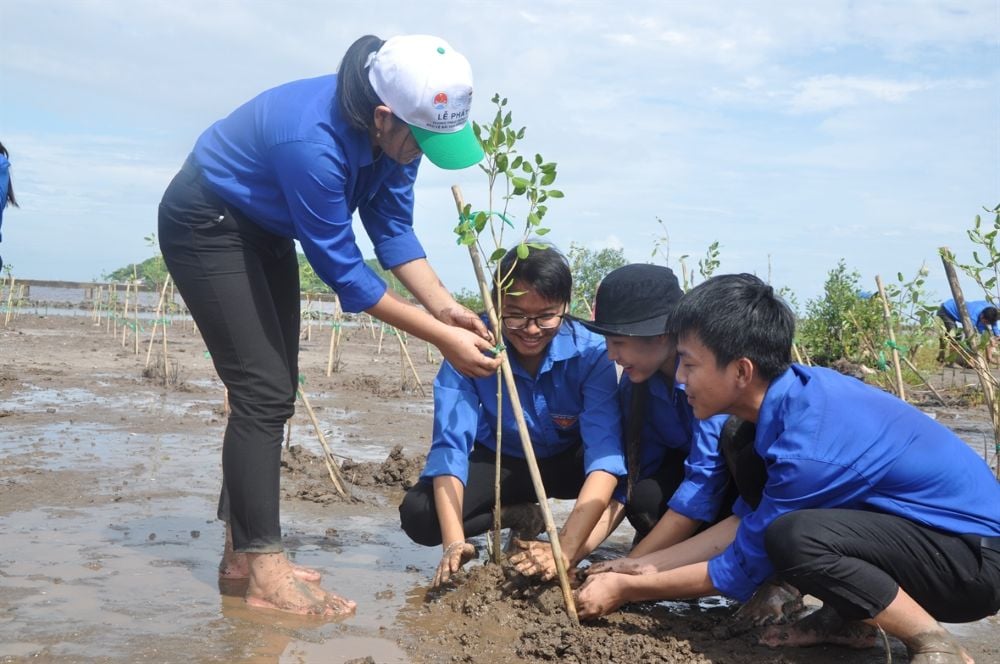
Accordingly, MRC aims to develop a Mekong River basin with a prosperous economy, sustainable environment , and climate change adaptation ... To achieve this goal, MRC member countries need to make good use of development opportunities and address challenges through a common process for the entire Mekong River basin, which is comprehensive, inclusive, and multi-sectoral; build a development planning framework and enhance the sharing of information and data on water use in the entire basin... Furthermore, MRC needs to play a more active role in coordinating interests among member countries and partners, sharing, ensuring water security of the Mekong River on the basis of mutual respect and in accordance with international law; focusing on The issue of improving the management and use of Mekong River water resources is an important content in the group of cooperation mechanisms between the Sub-region and external partners, which are also major countries with influence and bring many values to the Sub-region. This is most clearly demonstrated in the MUSP with the combination and inheritance of the foundations and achievements in the MRC and ACMECS so that the Mekong Sub-region countries can effectively solve the problem of improving the management and use of Mekong River water resources. This is also one of the basic contents of implementing cooperation between China and the Sub-region countries under the MLC framework. With China's participation, the MLC is expected to create more forums for dialogue between countries sharing Mekong River water resources , complementing the activities of the MRC, to jointly protect the river. The successful organization of the first Water Resources Cooperation Forum and the signing of the Cooperation Agreement between the MLC Water Resources Cooperation Center and the MRC Secretariat opens up prospects for increased sharing of hydrological data and information, cooperation in handling emergencies such as floods, droughts and other disasters, and enhancing management capacity to ensure sustainable and rational use of water resources. Through the forums, China affirmed its commitment to pursuing the principles of sustainable development, protecting the basin environment, not causing harm to downstream areas, and ensuring mutual benefits for all parties.
Along with promoting the Mekong cooperation process, it is necessary to continue to comply with the MRC's regulations on sustainable, reasonable and equitable use of water resources and other related resources of the Mekong River. Prioritize the full and effective implementation of the 1995 Mekong Agreement and the MRC's monitoring and coordination role in implementing the commitments of member countries. Continue to strengthen the current network of monitoring stations, especially speed up the construction of a common monitoring network on the impact of hydropower projects on the mainstream of the Mekong River; share information and data with member countries; seek opportunities to expand cooperation with development partners, dialogue to mobilize resources to continue supporting MRC activities . The Mekong Subregion countries need to discuss, research and propose solutions, as well as take the lead in implementing commitments and promoting the “Prior Consultation” process with partners in the MRC or possibly increasing the time for prior consultation. Research and amend the Notification, Prior Consultation and Agreement (PNPCA) procedures in a way that can achieve higher consensus and require consultation with communities living along the Mekong mainstream. In particular, seek ways to contribute to promoting and increasing the role and authority of the MRC, so that this organization has the right to make binding decisions, become a transparent “arbitrator” in assessing the risks of hydropower construction projects on the mainstream, and implement international legal principles on transnational water resources of the Mekong River.
In addition, although the countries in the Mekong Subregion all voted in favor of ratifying the 1997 Watercourses Convention, the provisions of the 1997 Watercourses Convention will not be effective when disputes or conflicts over water resources arise. Therefore, if all MRC members participate in the 1997 Watercourses Convention, it will create a regional legal framework to help minimize the risk of conflicts in the process of jointly exploiting and using the Mekong River water resources, ensuring the sustainable development of the Mekong River water resources.
As a country in the lower Mekong River, Vietnam always appreciates the role of the MRC and strongly commits to promoting close cooperation with member countries to successfully implement the strategies, plans and action programs of the MRC, for the goal of building an economically prosperous, socially equitable, environmentally healthy and climate-resilient Mekong River Basin. Vietnam strictly complies with and effectively implements the 1995 Mekong Agreement, as well as the established Water Use Regulations. Along with proactively participating in the development and implementation of important documents, legal documents, and strategies of the MRC; actively contributing to the sharing of information and data on water resources, etc., Vietnam is also a leading member country in efforts to enhance the image, position and importance of cooperation in the MRC in international and multilateral forums; promoting the spirit of solidarity and cooperation among Mekong countries, contributing to regional stability and cooperation; take into account the legitimate interests of all Mekong countries; promote cooperation between the MRC and its dialogue and development partners, as well as participate in promoting inter-basin cooperation activities, including the Ganges, Danube, Nile, Amazon and Mississippi river basins.
In addition, Vietnam actively participates in developing and implementing key cooperation programs and projects of the MRC, such as the Environment Program, Fisheries Program, Flood and Drought Management Program, Climate Change Response Program, Agriculture and Irrigation Program, Waterway Transport Program, Sustainable Hydropower Development Program, Mekong Integrated Water Resources Management Project... and actively and closely connects with activities to implement the ASEAN Community Vision, the United Nations Sustainable Development Goals, international commitments on climate change, as well as the Decade of Action "Water for Sustainable Development" for the period 2018 - 2028. In March 2022, Prime Minister Pham Minh Chinh approved the Mekong Delta Regional Planning for the period 2021 - 2030, with a vision to 2050. The Mekong Delta is currently facing economic, social and environmental challenges. Therefore, on the basis of determining the importance of MRC cooperation in implementing the 1995 Mekong Agreement, in the coming time, Vietnam needs to continue promoting cooperation with member countries of the Commission and international partners, contributing to peace, stability and promoting basin cooperation./.
----------------------------------
(1) It is a progressive river basin cooperation agreement in the world, with specific provisions; it is an important legal basis, stipulating the basic principles and common cooperation framework for member countries in the field of exploitation and protection of water resources and other related resources in the lower Mekong River basin, ensuring sustainable development, contributing to the implementation of socio-economic development strategies and key programs of member countries in the lower Mekong River basin. The Agreement consists of 6 chapters and 42 articles stipulating the objectives, principles of cooperation, fields, scope, institutional frameworks, organizational structure and methods of operation of the organization; at the same time, it also guides the mechanism for resolving disagreements arising between countries during implementation. The basic principles in cooperation between MRC member countries are consensus, equality and respect for territorial sovereignty. The international principle of fair and reasonable water use is also applied. Issues related to Mekong cooperation are considered and resolved through extensive consultation processes at many levels. The 1995 Mekong Agreement also aims to achieve the United Nations Millennium Development Goals and implement other international conventions related to management, exploitation, development of resources and environmental protection. Although it is a regional agreement and was signed two years before the 1997 Convention on the Law of Non-Navigational Uses of Transboundary Watercourses (the 1997 Watercourses Convention - the Convention adopted by the United Nations in 1997 is the first global legal document on the management of transboundary watercourses. On May 19, 2014, Vietnam joined the Convention, becoming the 35th member of the Convention, satisfying the condition on the number of participating countries for the Convention to come into force. According to regulations, the Convention comes into force on the 90th day from the date of deposit of the 35th instrument of ratification with the Secretary-General of the United Nations - August 17, 2014), the 1995 Mekong Agreement has many similar contents to the 1997 Watercourses Convention, and is even considered more complete than the 1997 Convention because the Convention does not require the parties of a The river basin must establish a river basin management organization as per the 1995 Mekong Agreement.
(2) “Mekong River Commission (MRC) - Mekong River Commission (MRC)”, https://tulieuvankien.dangcongsan.vn/ho-so-su-kien-nhan-chung/to-chuc-quoc-te/uy-hoi-song-me-cong-quoc-te-mrc-mekong-river-commission-mrc-3259
(3) Since its establishment, MRC has held four summits: the first in Thailand (April 2010); the second in Vietnam (April 2014); the third in Cambodia, April 2018; the fourth in Laos, April 2023.
(4) Bennett L. Beardena: “The legal regime of the Mekong River: a look back and some proposals for the way ahead”, Water Policy , No. 6, November 2010
(5) Including: 1- Exchange and Sharing of data and information; 2- Notification, Prior Consultation and Agreement; 3- Monitoring of water use; 4- Maintaining the flow on the mainstream; 5- Controlling water quality; 6- Technical guidelines for implementing these regulations. In particular, the Notification, Prior Consultation and Agreement (PNPCA) procedure requires MRC member countries to notify the MRC Joint Committee when participating in any infrastructure construction project on the Mekong mainstream. Accordingly, this procedure has helped MRC effectively implement the consultation process for hydropower projects on the Mekong mainstream. However, the PNPCA procedure does not bind members to reach an agreement, and the consulted countries cannot veto projects that may endanger water security in the lower Mekong basin.
(6), (7) To Minh Thu, Mekong Sub-region: Dynamic cooperation for prosperity, security and sustainable development, World Publishing House , Hanoi, 2021, pp. 97, 104
Source: https://tapchicongsan.org.vn/web/guest/quoc-phong-an-ninh-oi-ngoai1/-/2018/1146402/uy-hoi-song-mekong-quoc-te-sau-30-nam-thanh-lap--ket-qua%2C-han-che-va-trien-vong.aspx





![[Photo] Prime Minister Pham Minh Chinh chairs a meeting of the Government Standing Committee to remove obstacles for projects.](https://vphoto.vietnam.vn/thumb/1200x675/vietnam/resource/IMAGE/2025/10/06/1759768638313_dsc-9023-jpg.webp)


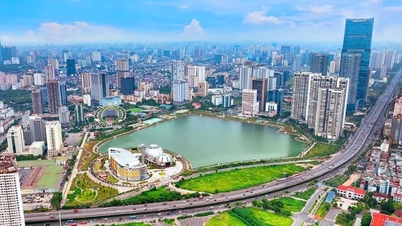



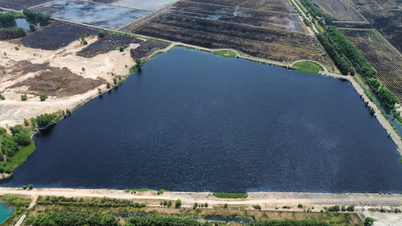

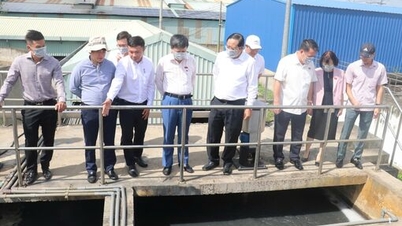

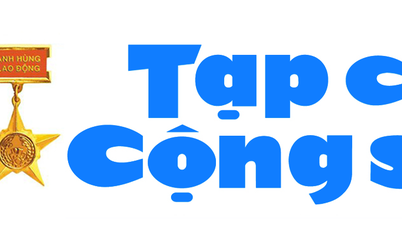
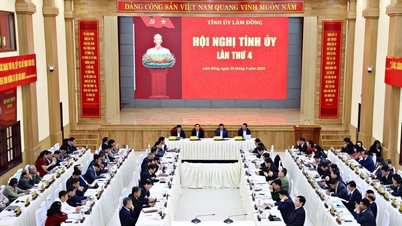





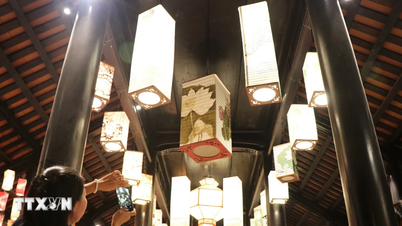
























































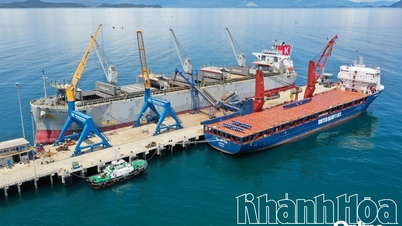













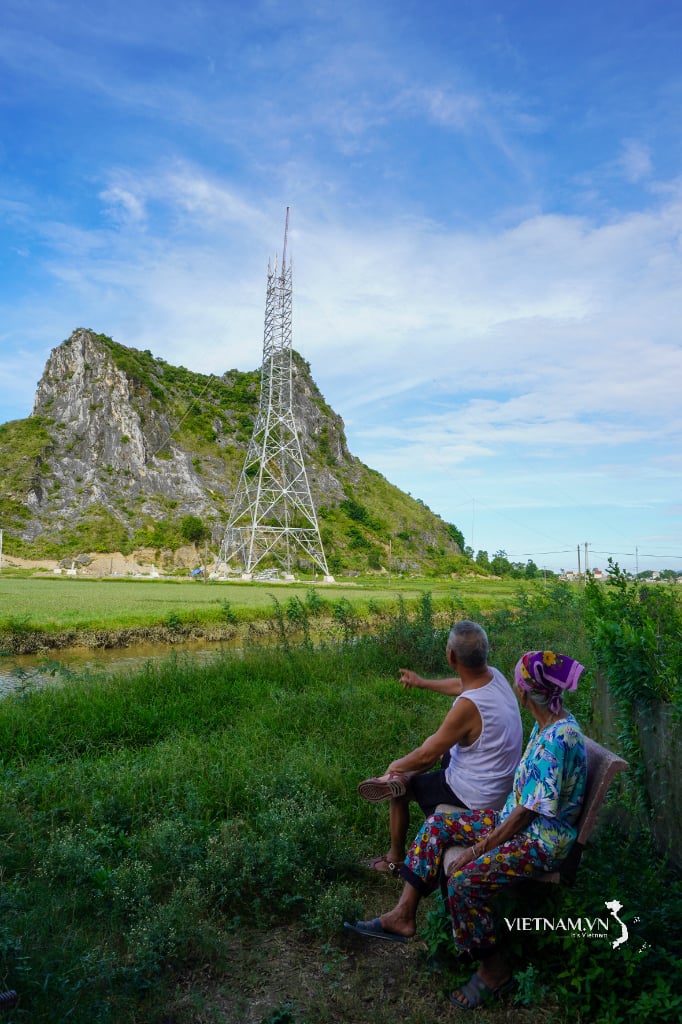


Comment (0)